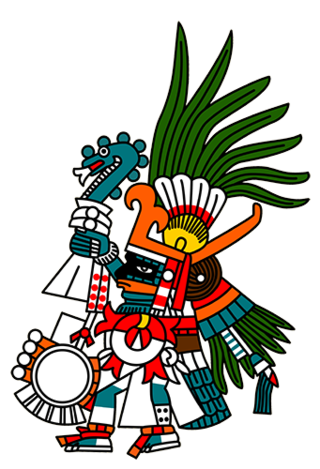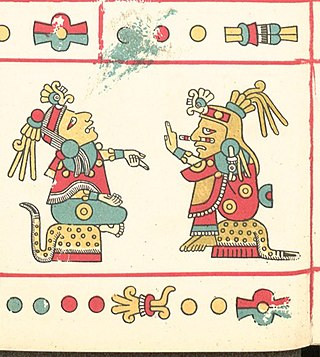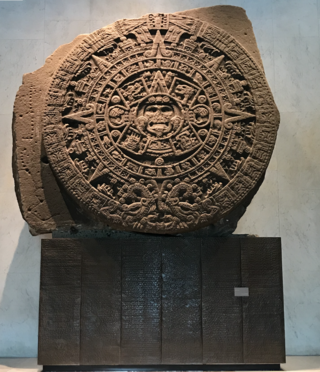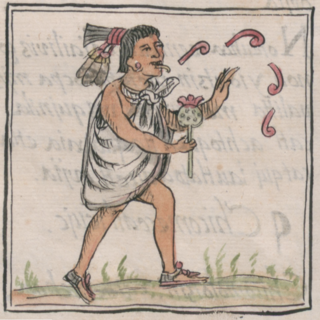Related Research Articles

Cuitláhuac or Cuitláhuac was the 10th Huey Tlatoani (emperor) of the Aztec city of Tenochtitlan for 80 days during the year Two Flint (1520). He is credited with leading the resistance to the Spanish and Tlaxcalteca conquest of the Mexica Empire, following the death of his kinsman Moctezuma II.

Aztec mythology is the body or collection of myths of the Aztec civilization of Central Mexico. The Aztecs were Nahuatl-speaking groups living in central Mexico and much of their mythology is similar to that of other Mesoamerican cultures. According to legend, the various groups who became the Aztecs arrived from the North into the Anahuac valley around Lake Texcoco. The location of this valley and lake of destination is clear – it is the heart of modern Mexico City – but little can be known with certainty about the origin of the Aztec. There are different accounts of their origin. In the myth, the ancestors of the Mexica/Aztec came from a place in the north called Aztlan, the last of seven nahuatlacas to make the journey southward, hence their name "Azteca." Other accounts cite their origin in Chicomoztoc, "the place of the seven caves", or at Tamoanchan.

The Aztecs were a Mesoamerican civilization that flourished in central Mexico in the post-classic period from 1300 to 1521. The Aztec people included different ethnic groups of central Mexico, particularly those groups who spoke the Nahuatl language and who dominated large parts of Mesoamerica from the 14th to the 16th centuries. Aztec culture was organized into city-states (altepetl), some of which joined to form alliances, political confederations, or empires. The Aztec Empire was a confederation of three city-states established in 1427: Tenochtitlan, the capital city of the Mexica or Tenochca, Tetzcoco, and Tlacopan, previously part of the Tepanec empire, whose dominant power was Azcapotzalco. Although the term Aztecs is often narrowly restricted to the Mexica of Tenochtitlan, it is also broadly used to refer to Nahua polities or peoples of central Mexico in the prehispanic era, as well as the Spanish colonial era (1521–1821). The definitions of Aztec and Aztecs have long been the topic of scholarly discussion ever since German scientist Alexander von Humboldt established its common usage in the early 19th century.

Ehecatl is a pre-Columbian deity associated with the wind, who features in Aztec mythology and the mythologies of other cultures from the central Mexico region of Mesoamerica. He is most usually interpreted as the aspect of the Feathered Serpent deity as a god of wind, and is therefore also known as Ehecatl-Quetzalcoatl. Ehecatl also figures prominently as one of the creator gods and culture heroes in the mythical creation accounts documented for pre-Columbian central Mexican cultures.

In Aztec mythology, Xochiquetzal, also called Ichpochtli Classical Nahuatl: Ichpōchtli, meaning "maiden"), was a goddess associated with fertility, beauty, and love, serving as a protector of young mothers and a patroness of pregnancy, childbirth, and the crafts practiced by women such as weaving and embroidery. In pre-Hispanic Maya culture, a similar figure is Goddess I.

Huitzilopochtli is the solar and war deity of sacrifice in Aztec religion. He was also the patron god of the Aztecs and their capital city, Tenochtitlan. He wielded Xiuhcoatl, the fire serpent, as a weapon, thus also associating Huitzilopochtli with fire.

Ōmeteōtl is a name used to refer to the pair of Aztec deities Ometecuhtli and Omecihuatl, also known as Tōnacātēcuhtli and Tonacacihuatl. Ōme translates as "two" or "dual" in Nahuatl and teōtl translates as "phenomena". The existence of such a concept and its significance is a matter of dispute among scholars of Mesoamerican religion. Ometeotl was one as the first divinity, and Ometecuhtli and Omecihuatl when the being became two to be able to reproduce all creation.

The Aztec or Mexica calendar is the calendrical system used by the Aztecs as well as other Pre-Columbian peoples of central Mexico. It is one of the Mesoamerican calendars, sharing the basic structure of calendars from throughout the region.

The Nahuas are a Uto-Nahuan ethnicity and one of the indigenous people of Mexico, with Nahua minorities also in El Salvador, Guatemala, Honduras, Nicaragua, and Costa Rica. They comprise the largest indigenous group in Mexico, as well as the largest population out of any North American Indigenous people group who are native speakers of their respective indigenous language. Amongst the Nahua, this is Nahuatl. When ranked amongst all Indigenous languages across the Americas, Nahuas list third after speakers of Guaraní and Quechua.

Tlahtoāni is a historical title used by the dynastic rulers of āltepēmeh, autonomous political entities formed by many pre-Columbian Nahuatl-speaking peoples in the Valley of Mexico during the Postclassic Period. The title of huēyi tlahtoāni was used by the rulers of the Aztec Empire, an alliance between the āltepēmeh of Tenochtitlan, Tetzcoco, and Tlacopan.
Classical Nahuatl, also known simply as Aztec or Codical Nahuatl and Colonial Nahuatl, is a set of variants of Nahuatl spoken in the Valley of Mexico and central Mexico as a lingua franca at the time of the 16th-century Spanish conquest of the Aztec Empire. During the subsequent centuries, it was largely displaced by Spanish and evolved into some of the modern Nahuan languages in use. Although classified as an extinct language, Classical Nahuatl has survived through a multitude of written sources transcribed by Nahua peoples and Spaniards in the Latin script.
Diego Durán was a Dominican friar best known for his authorship of one of the earliest Western books on the history and culture of the Aztecs, The History of the Indies of New Spain, a book that was much criticised in his lifetime for helping the "heathen" maintain their culture.

The altepetl was the local, ethnically-based political entity, usually translated into English as "city-state", of pre-Columbian Nahuatl-speaking societies in the Americas. The altepetl was constituted of smaller units known as calpolli and was typically led by a single dynastic ruler known as a tlatoani, although examples of shared rule between up to five rulers are known. Each altepetl had its own jurisdiction, origin story, and served as the center of Indigenous identity. Residents referred to themselves by the name of their altepetl rather than, for instance, as "Mexicas". "Altepetl" was a polyvalent term rooting the social and political order in the creative powers of a sacred mountain that contained the ancestors, seeds and life-giving forces of the community. The word is a combination of the Nahuatl words ātl and tepētl. A characteristic Nahua mode was to imagine the totality of the people of a region or of the world as a collection of altepetl units and to speak of them on those terms. The concept is comparable to Maya cah and Mixtec ñuu. Altepeme formed a vast complex network which predated and outlasted larger empires, such as the Aztec and Tarascan state.
Culhuacan was one of the Nahuatl-speaking pre-Columbian city-states of the Valley of Mexico. According to tradition, Culhuacan was founded by the Toltecs under Mixcoatl and was the first Toltec city. The Nahuatl speakers agreed that Culhuacán was the first city to give its rulers the title of "speaker" (tlatoani). In the sixteenth century following the Spanish conquest of the Aztec Empire, Culhuacan was incorporated into colonial New Spain and called a pueblo, but in local-level documentation in Nahuatl, residents continued to use the designation altepetl for their settlement.

The traditions of indigenous Mesoamerican literature extend back to the oldest-attested forms of early writing in the Mesoamerican region, which date from around the mid-1st millennium BCE. Many of the pre-Columbian cultures of Mesoamerica are known to have been literate societies, who produced a number of Mesoamerican writing systems of varying degrees of complexity and completeness. Mesoamerican writing systems arose independently from other writing systems in the world, and their development represents one of the very few such origins in the history of writing.

The Mexica are a Nahuatl-speaking people of the Valley of Mexico who were the rulers of the Triple Alliance, more commonly referred to as the Aztec Empire. The Mexica established Tenochtitlan, a settlement on an island in Lake Texcoco, in 1325. A dissident group in Tenochtitlan separated and founded the settlement of Tlatelolco with its own dynastic lineage. In 1521, their empire was overthrown by an alliance of Spanish conquistadors and rival indigenous nations, most prominently the Tlaxcaltecs. The Mexica were subjugated under the Spanish Empire for 300 years, until the Mexican War of Independence overthrew Spanish dominion in 1821. In the 21st century, the government of Mexico broadly classifies all Nahuatl-speaking peoples as Nahuas, making the number of Mexica people living in Mexico difficult to estimate.
Cuāuhtlahtoāni or Cuäuhtlahtoh is a titular office of governorship and political administration, used within certain city-states and provinces among the Aztecs of pre-Columbian central Mexico in the Late Postclassic period. The office of cuauhtlatoani carried the connotation of "military ruler" or "appointed administrator". During the rise of the Aztec Empire the title was given by the ruling Mexica-Tenochca to the governors they imposed on conquered city-states in central provinces.

Tenayuca is a pre-Columbian Mesoamerican archaeological site in the Valley of Mexico. In the Postclassic period of Mesoamerican chronology, Tenayuca was a settlement on the former shoreline of the western arm of Lake Texcoco. It was located approximately 10 kilometres (6.2 mi) to the northwest of Tenochtitlan.

Nahuatl, Aztec, or Mexicano is a language or, by some definitions, a group of languages of the Uto-Aztecan language family. Varieties of Nahuatl are spoken by about 1.7 million Nahuas, most of whom live mainly in Central Mexico and have smaller populations in the United States.
Cēmānāhuac was the name used by the Aztecs to refer to their world. It corresponds to the modern term Mesoamerica.
References
- 1 2 One or more of the preceding sentences incorporates text from a publication now in the public domain : Chisholm, Hugh, ed. (1911). "Anáhuac". Encyclopædia Britannica . Vol. 2 (11th ed.). Cambridge University Press. p. 911.
- ↑ Torres Solórzano, Carla (September 18, 2010). "Choque de lenguas o el mestizaje de nuestro idioma" [Clash of languages or the mixing of our language]. La Prensa (in Spanish). Retrieved April 12, 2017.
- ↑ "La raíz nahuatl de nuestro lenguaje" [The Nahuatl root of our language]. El Nuevo Diario (in Spanish). August 10, 2004. Retrieved July 3, 2017.